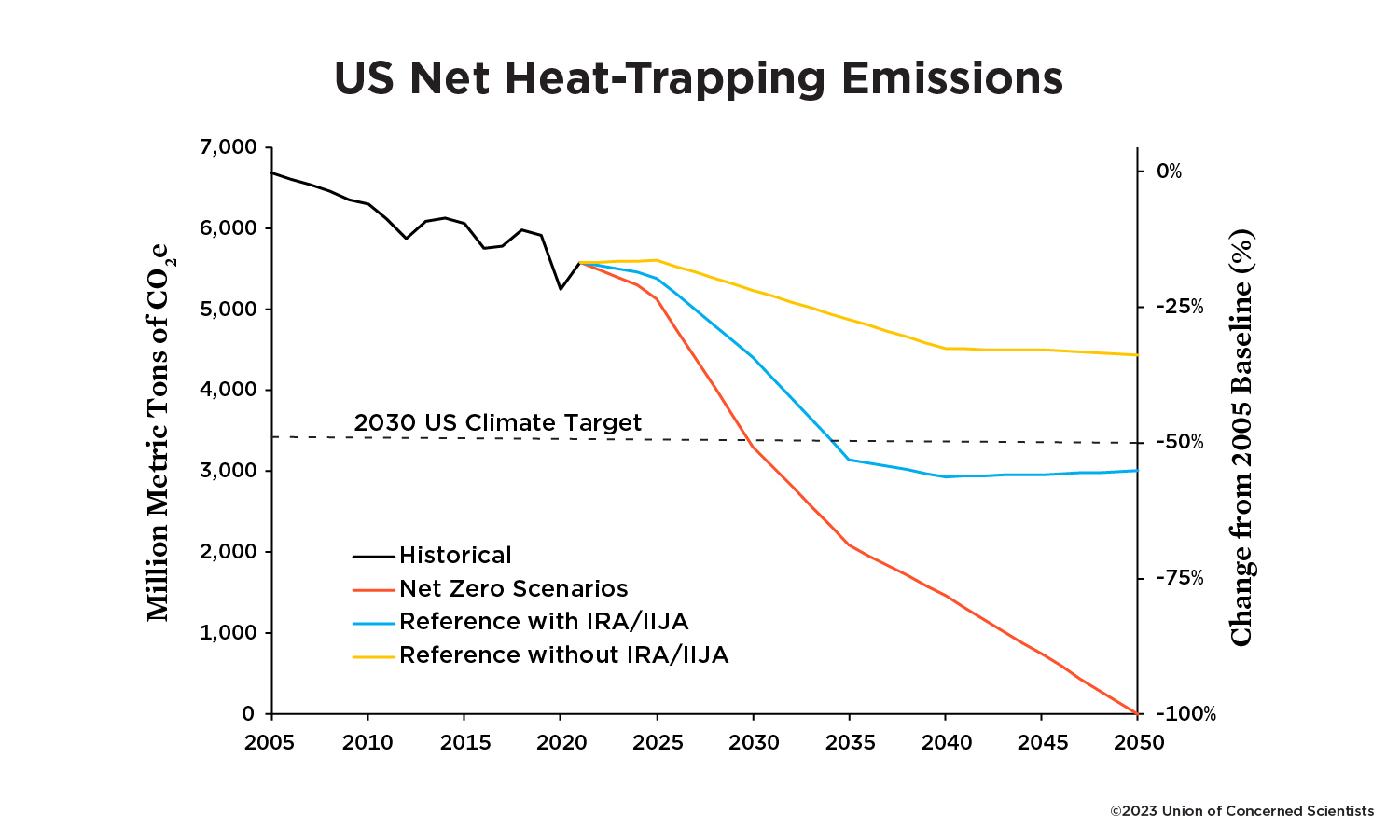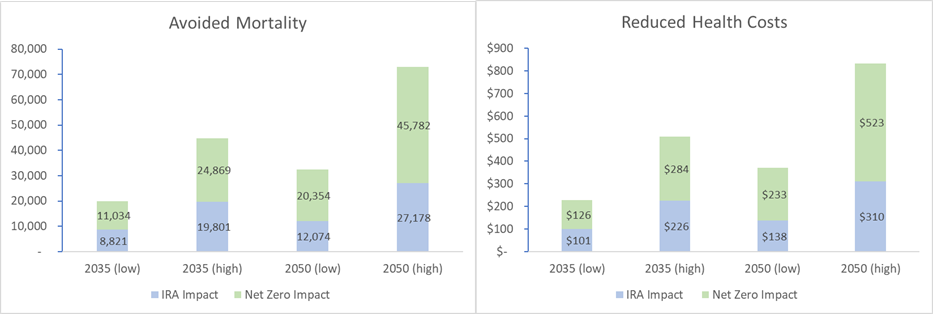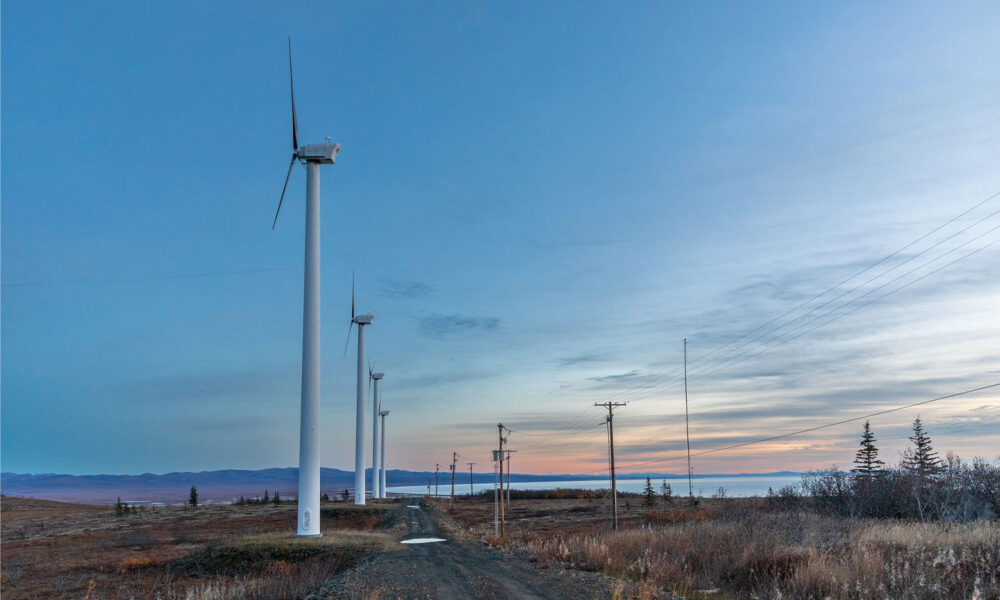There is so much bad news about climate change these days. Global temperature records are being shattered, climate impacts are worsening rapidly around the world, and the latest IPCC report makes clear that critical global climate goals are on the verge of slipping from our grasp.
So today I’m glad to share some good news: a new UCS study that gives me fresh hope and determination to keep fighting for necessary actions to drive deep cuts in US heat-trapping emissions.
New UCS study shows how we can accelerate US clean energy ambition
An interdisciplinary team of UCS experts set out to explore how the US can meet its goals to cut heat-trapping emissions 50%-52% below 2005 levels by 2030 and achieve net zero emissions no later than 2050. We found that it’s definitely feasible and, what’s more, we can reap significant health and economic benefits by rapidly transitioning away from fossil fuels to clean energy.
The full report, an executive summary and a technical appendix are available online. My colleagues and I will also be further unpacking the key findings and implications of this analysis through blogs in the weeks ahead. The executive summary is also available in Spanish.
Our findings are not about a Pollyannaish version of the future. Achieving these emissions reduction goals is not going to be easy and it will require concerted action and significant investments within this decade and beyond.
We’re going to have to quickly accelerate the clean energy momentum already underway and go well beyond what current policies like the Inflation Reduction Act (IRA) and other state and federal policies can deliver. Meanwhile, the current US expansion of fossil fuel production and use is completely at odds with climate goals, and we have to push policymakers to implement a fast, fair phaseout of fossil fuels instead.
Our research makes tangible why the healthier, fairer clean energy future we want and need is directly linked to the choices we make today.
Three key insights from the new UCS study
Our modeling framework, based on models developed by Evolved Energy, includes several scenarios to illuminate the impacts of different assumptions under two Reference cases (with and without the IRA) and two Net Zero cases (both of which meet US climate goals but have different overall US energy demand assumptions). Here are some of the main findings of our analysis:
- Making deep cuts in US heat-trapping emissions in line with science and international commitments is feasible, but only with significant new policies and investments.
We found that, by ramping up investments in clean energy across the economy, the US can meet its near and long-term climate goals. The IRA and other existing state and federal policies are significant drivers of clean energy in the near term, but they are not enough on their own to meet 2030 goals—and, in the case of the IRA, its contribution will level out past 2035 (see graph below). That’s why it’s crucial for federal and state policymakers to enact more ambitious clean energy policies to close the gap, as shown in the net zero scenarios below.

Effective implementation of the IRA and other existing policies cuts economy-wide emissions 34% below 2005 levels in 2030 and 53% by 2035. Under the Net Zero cases, we assume bolder action to meet 2030 targets and drive emissions to net zero by 2050. Source: UCS
Three key solutions account for most of the emission reductions needed to meet US climate goals: decarbonizing the power sector, electrifying as many energy end uses as possible, and ramping up energy efficiency. All three are proven, commercially available, and can lower energy bills, increase public health benefits, and readily be ramped up to much higher levels to replace fossil fuels. Under the net zero scenario:
- Wind, solar, and other renewables nearly triple their share of US electricity generation from 22% in 2021 to 60% in 2030, 81% in 2035, and 92% in 2050.
- Coal is phased out of the power sector by 2030. Overall economywide fossil fuel use falls 50% between 2021 and 2040 and 82% by 2050.
- US transmission capacity increases 36% by 2030, more than doubles by 2040, and quadruples by 2050.
- Electric vehicle sales grow rapidly, with 100% of sales of personal cars and trucks and medium- and heavy-duty trucks being battery electric and fuel cell vehicles by 2035. By 2040, EVs account for 75% of all vehicles on the road.
- Electricity use grows 31% between 2021 and 2030 and more than triples by 2050 primarily due to increased electrification of transportation, buildings, and industry.
- Ramping up energy efficiency and electrification reduces overall US energy demand by nearly 22% between 2021 and 2050. We also explored a more ambitious pathway assuming broader economic and societal changes (beyond sectoral energy efficiency) that would help deliver an overall reduction in US energy demand of 34% by 2050 under a Net Zero/Low Demand scenario.
- Transitioning away from fossil fuels to clean energy saves consumers money, protects lives, and safeguards public health.
Our analysis shows that investments in clean energy more than pay off through savings in fossil fuel costs for consumers and the significant avoided costs in public health and climate harms.
The Net Zero scenario results in net savings in consumer energy costs of more than $100 billion in 2030. The IRA and Net Zero scenarios also drive significant reductions in nitrogen oxides (NOx), sulfur dioxide (SO2), and fine particulate matter (PM2.5). The reductions in PM2.5 alone are a huge public health boon, cutting mortality by up to 73,000 deaths and resulting in up to $830 billion annually in public health benefits by 2050 (see graph below). In addition, the avoided climate damages from reduced carbon emissions, calculated using the social cost of carbon, exceed $400 billion by 2035 under the IRA Reference case and nearly $1.3 trillion by 2050 under the Net Zero case.
Public health benefits of reductions in PM2.5 under the IRA and Net Zero scenarios

Reductions in PM2.5 from reduced fossil fuel use drive significant public health benefits, including reduced mortality and reduced health costs relative to the Reference case without the IRA. These benefits are greater for the Net Zero scenario (green plus blue bars) compared with the IRA scenario alone (blue bars). The high and low range is derived from estimates from EPA’s COBRA model. Source: UCS
- Changes in governance and institutions and decision-making are crucial to building a fair and just low-carbon economy.
While the direct findings from our study are focused on energy system metrics, it’s crystal clear that the kinds of shifts required to meet climate goals will require transformative changes to ways of making and implementing energy choices.
We need strong, fair institutions and governance to help ensure a rapid transition to clean energy with equitable benefits for all—especially those most marginalized and historically disadvantaged. It’s also critical to dismantle the power the fossil fuel industry has over our nation’s energy policies and hold them accountable for the harms their products cause.
Inclusive governance and decision-making are especially important for technologies that could have significant social and environmental impacts beyond their carbon implications (e.g., carbon capture and storage and carbon dioxide removal, which show up in a bounded way in our model results).
Inclusive decision-making processes and strong environmental and social safeguards are also necessary for the siting and permitting of large clean energy projects and procurement of minerals required for technologies such as batteries. A scenario with lower overall energy demand would reduce the infrastructure buildout necessary to meet climate goals and their associated siting and materials challenges.
The oft-used frame of “tough tradeoffs” in assessing technological choices is not neutral within a socioeconomic and energy system built on inequities and environmental injustices, tilted toward pushing adverse outcomes onto communities and people who have long borne such burdens.
Connecting the national to the global
The IEA World Energy Outlook 2023 shows that, without concerted action by policymakers, current global energy choices are causing us to hurtle toward a dangerous 2.4˚C world. But with focused, ambitious action, nations can sharply bend the emissions curve.
As a relatively wealthy nation and the leading contributor to historical heat-trapping emissions, the US has a unique responsibility to contribute to global efforts through direct cuts to its harmful emissions, as well as through climate finance to help low- and middle-income countries also make a clean energy transition. Of course, other wealthy and major emitting nations must also step up their ambition so that collectively we can reckon with this global challenge. Living up to our nation’s commitments is critical to building the goodwill, trust, and cooperation it takes to solve major world problems like climate change.
Our analysis is the latest in a string of analyses—including from the NAS, Princeton, NRDC and the Rhodium Group—that shows that it is both (still) possible and in our nation’s self-interest to make deep cuts in carbon emissions, but the window is closing fast. Decades of inaction from policymakers and the deception and obstruction of fossil fuel companies have stood in the way of progress. Delay is costly; it has created a very daunting challenge, whereby we have no time to lose in making rapid, transformative shifts in our energy system to have any hope of meeting climate goals.
At COP28, the upcoming annual UN climate talks in Dubai at the end of the year, nations must come together to secure agreement on a fast, fair phaseout of fossil fuels, alongside a massive ramp up of renewable energy and energy efficiency. Cutting energy related heat-trapping emissions sharply within this decisive decade and beyond is crucial to limit the pace and magnitude of climate change, which is already taking a fearsome toll on people around the world. That’s why more than 650 scientists joined a letter led by UCS to urge President Biden to commit to this outcome as part of a set of key asks for COP28.
Joining the fights for climate, environmental, and worker justice
Our modeling results show that phasing out coal by 2030 is critical to meeting climate goals, and will also be a huge public health boon.
Prioritizing those benefits for low-income communities and communities of color which have long been overburdened by pollution will take specific policy focus. But fossil gas and oil persist in our results, albeit at much reduced levels—and, if history is any guide, that will have a disproportionately negative impact on those very same communities relative to the rest of the country.
Meanwhile, rapidly phasing out fossil fuels without paying attention to policies and investments for workers and communities currently dependent on these resources will risk leaving them economically harmed.
Aligning climate, environmental and worker justice goals will require intentional policies—it won’t happen automatically. That is a fundamental truth that more climate advocates must clearly acknowledge because for far too long we have made sweeping arguments that addressing climate change would automatically deliver benefits to all.
In fact, how we meet our climate goals and how we make a clean energy transition can significantly affect who gets to benefit first and most and who is at risk of being left behind or saddled with the losing end of societal tradeoffs.
Implementing the IRA with robust Justice40 provisions is crucial, but we must do more. We must ensure that our policy choices are not simply driven by techno-economic considerations, but also include strong environmental and social safeguards and high-road labor standards so that they align with what people need and want. We also need to ensure all of our clean energy infrastructure is also climate resilient.
For decades, environmental justice advocates have led the fight for a pollution-free economy. Labor rights advocates have fought for an economic system that treats workers fairly. Aligning climate outcomes with those necessary goals is both the just approach, and the only approach that will ensure that people are at the center of our shared vision for a better future.
Energy modeling pathways primarily focused on carbon emissions are but one input in that discussion—they should not be considered determinative of the future, nor are they comprehensive in their outlook. We have to look beyond carbon and prioritize choices that benefit communities equitably and across multiple pressing dimensions.
We can and must secure that brighter clean energy future
The future we want—and need—is within our grasp, and it’s so worth fighting for! I hope you feel the same way. Please urge your policymakers to step up and do their job to help secure a clean energy transition.

